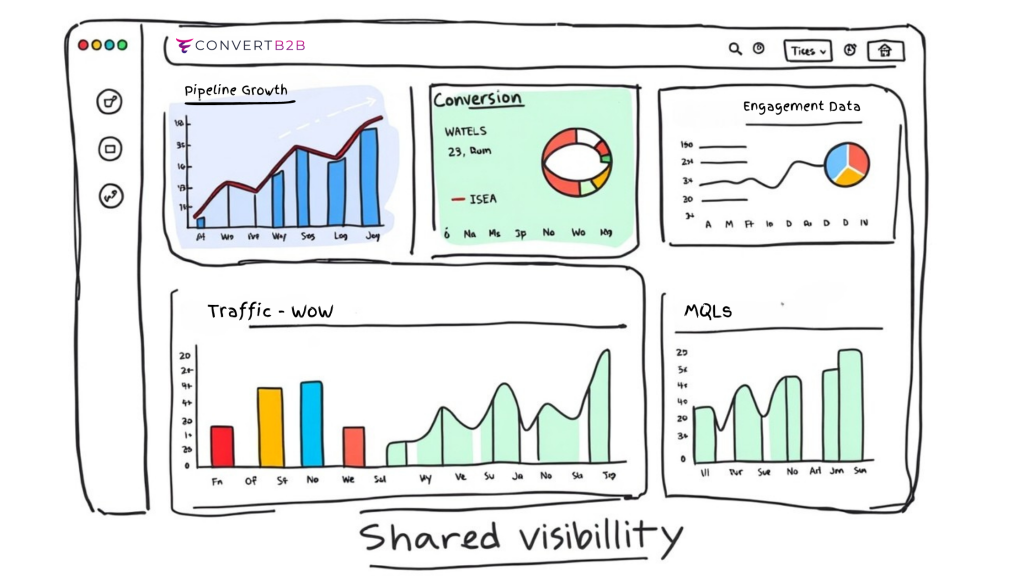Blog
How Sales and Marketing Can Truly Align to Make ABM Work

When sales and marketing teams aren’t aligned, progress stalls. In Account-Based Marketing (ABM), alignment isn’t just nice to have—it’s a dealbreaker. If ABM is about creating personalized experiences for your most valuable prospects, sales and marketing need to work together seamlessly. Let’s unpack why this alignment matters and how to achieve it, step by step.
Why Do Sales and Marketing Often Clash?
To start, let’s face the facts: sales and marketing are wired differently. Sales is like the sprinter—focused on closing deals quickly and meeting quotas. Marketing, on the other hand, is like the marathon runner—working on the long game of brand building and lead generation.
A study by InsideView and Demand Gen Report found that nearly half (49%) of companies struggle with communication breakdowns between these teams. Misaligned processes (43%) and clashing performance metrics (40%) only make things worse. Imagine sales expecting high-value leads while marketing’s goals are to simply increase web traffic. You end up with frustration on both sides and zero progress.
What makes it trickier is unclear expectations. Sales might not follow up on leads because they don’t trust marketing’s criteria. Meanwhile, marketing feels sales doesn’t appreciate their hard work. Sound familiar?

Bridging the Gap: The Role of Data and Processes
The good news? Alignment isn’t an unsolvable puzzle. The first step is to get everyone on the same page with data and processes. Lack of quality data is a huge hurdle—52% of teams struggle with segmentation, and 74% lack the customer intelligence needed for successful prospecting. You can’t align if you’re working from different maps.
Start by defining what makes a “good lead.” This includes basics like company size, industry, and seniority, but also engagement signals like website visits or content downloads. A Service Level Agreement (SLA) can formalize this, spelling out who’s responsible for what.
For instance:
- Marketing’s job: Generate 50 qualified leads per month based on agreed criteria.
- Sales’ job: Follow up on those leads within 48 hours.
When everyone knows their role, there’s less room for finger-pointing. Additionally, consider integrating account scoring models that both teams agree on. These models assess accounts not just by demographic fit but by behavioral indicators, like repeated engagement with high-value content. By using predictive analytics, teams can focus their efforts on accounts most likely to convert, ensuring no energy is wasted on unqualified leads.

Tools That Turn the Tide
Technology is your best friend here. Tools like LinkedIn Sales Navigator let sales teams dig deeper into target accounts, understand buyer motivations, and personalize their outreach. Companies using these tools report better ROI, higher quotas achieved, and stronger pipelines.
Take HCL Technologies, for example. By integrating Sales Navigator into their CRM, they closed $500 million worth of contracts in just two quarters. Or Dell, which used automated, personalized content to boost customer engagement by 300% and increase order value by 35%. These tools help sales and marketing move as a single, cohesive unit.
For smaller organizations with limited budgets, free or lower-cost solutions like HubSpot’s free CRM or basic email tracking tools can also work wonders. These tools foster transparency by giving both teams access to real-time data on customer interactions, allowing for immediate course corrections if needed.
What Alignment Looks Like in Practice
So, how do you actually put alignment into action? Here’s a real-world example from American Express. Their marketing team created a content hub tailored to customer pain points. Sales used this hub to guide conversations with prospects, resulting in higher engagement and smoother deals. This cross-functional collaboration wasn’t just smart; it was essential.
Another best practice is holding regular “Smarketing” meetings. These sessions allow both teams to:
- Share insights about what’s working (and what’s not).
- Test campaigns together in real-time.
- Create feedback loops to improve strategy.
A great analogy? Think of sales as the striker in soccer and marketing as the midfielders. Without the midfielders setting up plays, the striker doesn’t score. But without the striker finishing, the team doesn’t win.
Even more crucial are shared dashboards that track metrics both teams care about. By creating a unified view of progress—whether it’s pipeline growth, conversion rates, or customer lifetime value—teams stay aligned on outcomes, not just activities. This visual accountability fosters mutual respect and trust.
Celebrate the Wins Together
Alignment isn’t just about processes and tools; it’s also about culture. Celebrate joint wins to build trust. Did sales close a big account? Give marketing credit for the lead-gen strategy. Did marketing nail a campaign that got great traction? Let sales chime in on how it helped their outreach.
Recognizing each other’s contributions fosters a collaborative mindset. It’s no longer “this is my job, that’s yours,” but rather, “we’re in this together.”
Beyond celebrations, investing in cross-training can further deepen understanding. By letting marketing teams sit in on sales calls and vice versa, both sides can appreciate the challenges and opportunities of the other, paving the way for a stronger partnership.
The Big Picture: Why Alignment Matters
At the end of the day, ABM is about three Rs: Reputation, Relationships, and Revenue. When sales and marketing are aligned, you’re not just reaching accounts—you’re influencing decision-makers, building trust, and driving long-term value.
The Gartner Group calls this “Sensemaking.” Instead of overwhelming buyers with information, aligned teams simplify their journey. They collaborate to:
- Organize data so it’s easy for buyers to process.
- Highlight trade-offs and guide smart decisions.
- Build confidence, leading to bigger, better deals.
Buyers exposed to aligned sales and marketing efforts are 80% more likely to make high-quality purchases. That’s the power of rowing in sync.
Sales and marketing alignment isn’t just a buzzword; it’s the backbone of successful ABM. It takes communication, shared goals, the right tools, and a culture of collaboration to make it work. But when it does, the results speak for themselves—higher engagement, faster deal cycles, and more revenue.
So, let’s grab those paddles and start rowing in the same direction.
Your ABM success depends on it.

